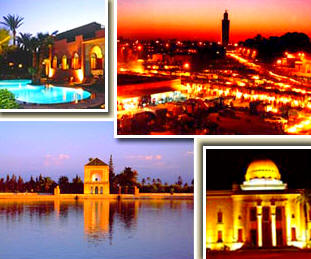 Marrakesh Marrakesh
Marrakesh is the second oldest Imperial
city, known as the ‘Pearl of the South’ or the ‘red city’. It was
founded in 1062 by the Almoravids from the Sahara and taken by the
Almohads almost a century later. It was the Saadian dynasty during
the 16th century, who gave Marrakesh the Saadian Tombs, the Ben
Youssef Medersa and the Palais El-Badi, which today are the city’s
most frequented touristic sights. In 1668 Marrakesh’s golden age
ended when the Alaouites made Fez, and later Meknes, their capital.
The rich history of Marrakesh reflects in its various quarters and
monuments today.
Koutoubia
To mark his victory over the Almoravids in 1147, the Almohad sultan
Abd el-Moumen set about building one of the largest mosques in the Western Muslim world. The
minaret, a masterpiece of Islamic architecture, was completed during
the reign his grandson of Yacoub el-Mansour. It later served as a
model for the Giralda in Sevilla,
as well as for the Hassan Tower in
Rabat. The ‘Booksellers’ Mosque takes its name
from the manuscripts souk that once took place around it. The
minaret is the highest building in the city and only Muslims
may enjoy the unforgettable view
from the top of the building. The
mosque has been restored to reveal the original pink colour of
the brickwork.
Saadian Tombs
Although they were neglected for more than two centuries, the tombs
of the Saadian dynasty constitute some of the finest examples of the
Islamic architecture in Morocco. Their style is in complete contrast
to the simplicity of Almohad architecture, as the Saadian princes
lavished on funerary architecture the same splendor and magnificence
that they gave to the other buildings.
Until 1917 there was a wall around the main entrance, built by the
Alaouite sultan Moulay Ismail out of respect for the dead. Nowadays
open to the public, we find the mausoleum of Ahmed el-Mansour and
his successors and a flower garden symbolizing Allah’s paradise.
Ben Youssef Medersa
This Koranic school is not only one of the finest but also one of
the largest in the Maghreb, with a capacity of 900 students.
It was founded by the Merinid sultan
Abou el-Hassan in the mid-14th century and was rebuilt by the
Saadian sultan Moulay Abdallah in the 16th century, whose desire was
to restore to Marrakech the prestige of an imperial capital and
simultaneously
to affirm his devotion to Allah.
Djemaa El Fna and its souks
Declared a World Heritage Site by UNESCO, this unique and
extraordinary square has been for centuries the nerve centre
of Marrakesh and the symbol of the city.
In the morning there is a large market with medicinal plants,
freshly squeezed oranges
and all kinds of nuts and confectionery.
Later in the day the square transforms in an arena of a gigantic
open-air show with snake charmers, fortune tellers, monkey handlers,
musicians, dancers and the air filled with smoke and aroma of
grilled meat and spices.
Djemaa El Fna truly is a place of nonstop entertainment. On the
North and East of the square you can enter the narrow streets into
the most fascinating souks of Morocco. This labyrinth of streets
displays a very wide variety of good, from fabric to jewellery
and slippers, to traditional crafts of
leatherwork, basketry and carpets, making a walk in the souks a true
journey through time.
Bahia Palace
This palace, whose name means “Palace of the Favourite”, was built
by two powerful grand viziers at the end of the 19th century.
It consists of 2 parts, each built in
different times: the older part, built by Si Moussa (vizier of
sultan Sidi Mohammed ben Aberderrahman), and the new part, built by
his son Ba Ahmed (vizier of Moulay Abdelaziz). They both consist of
luxurious
apartments and tree planted courtyards,
each in a unique and different style. Marshal Lyautey chose to live
here during the Protectorate.
La Mamounia Hotel
Opened in 1929, the legendary La Mamounia Hotel stands on the site
of a residence that belonged to the son of the Alaouite sultan Sidi
Mohammed in the 18th century. All that remains of that residence is
the magnificent 130.000m² (32 acre) garden, planted with olive and
orange trees and containing a pavilion that was built by a Saadian
ruler in the 16th century. The hotel was designed by Henri Prost and
Antoine Marchisio, who achieved a pleasing combination of Art Deco
and Moorish styles. Many famous people, including Winston Churchill,
Richard Nixon and Orson Welles, have stayed in Marrakesh’s most
famous and luxurious hotel.
http://www.mamounia.com/en/intro.htm
Majorelle Garden
In 1923 Jacquese Majorelle fell in love with Morocco and built
himself a splendid Moorish villa around which he laid out a
luxuriant garden. The house was later bought by Yves Saint Laurent
and Pierre Bergé and its garden opened to the public in 1955. The
bright blue of the house combined with numerous coloured tropical
flowers, over 400 varieties of palm tree and 1.800 species of
cactus, truly reflect a small paradise. The studio next to the house
has been converted into a small museum with a selection of Moroccan
crafts and paintings by Jacques Majorelle.
www.jardinmajorelle.com/ang/
Weather:
Winter temperature = 10 - 20°C Summer temperature = 25 – 45°C
Hot and dry climate, with little humidity. Big night/day temperature
difference
Festivals:
International Film Festival Winter
Official website of the festival:
http://en.festivalmarrakech.info
Popular Arts Festival July
Official website of the festival:
http://www.marrakechfestival.com/
Official website of the festival:
International Humour Festival June
http://marrakechdurire.com/ |